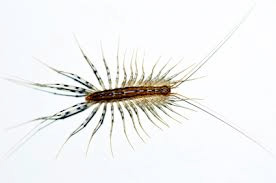ManageSafe
Least-Toxic Control of Centipedes Choose a different pests

|
Factsheet: Least-toxic Control of Centipedes
Identification
Pest type: Insects
In-depth Information:
Centipedes are elongated, flattened, worm-like creatures with 15 or more pairs of legs, which move very quickly. Close examination reveals one pair of legs per body segment, unlike millipedes that have two or more pairs per body segment. The most common centipede in eastern U.S. and Canada sometimes enters homes and feeds on flies, spiders and other household pests. They can bite when handled carelessly, but are harmless to humans. A larger centipede with shorter legs is more common in southern U.S. These do not normally enter houses, and are usually found beneath logs or stones. Their bites are more painful but never fatal to humans.
Is it a problem?
Threshold tolerances then should be high for these critters as they provide a natural insect control: they eat fleas, ants, flies, silverfish, roaches, ticks and other pests around the home as well as in the garden.
Additionally, centipedes rarely bite people, and sometimes their jaws aren’t even strong enough to pierce human skin in self-defense. If they manage it, a centipede bite will usually resemble a minor bee sting, though their bite is not poisonous.
Pest prevention practices
Remove food sources
Dispose of trash
Place trash in sealed containers
Store food in air-tight, sealed containers
Remove potential habitat
Vacuum frequently.
Fix all holes in screens and cracks in the foundation or basement walls.
Reduce moisture within the home, repair all leaks and provide adequate ventilation to damp areas.
Monitoring and record-keeping
Keep an eye around the house for entry points for centipedes. If needed set sticky traps around the house to monitor levels. Remember that these are beneficial bugs that eat other pests.
Non-chemical and mechanical controls
Repair holes
Create a barrier
Sticky traps
Vacuum
In-Depth Information:
Sticky traps may also be useful for the control of small centipedes. Just place them in corners and crevices where centipedes tend to hunt. You may also catch other insects that are sneakily crawling around your home. Know that larger centipedes that walk over sticky or glue traps may escape by simply leaving behind a couple legs. Sticky traps are most effective for smaller centipedes, not larger ones.
Biological controls
Biological controls within the home are ineffective for centipedes.
Least-toxic chemical options as a last resort
- Dust formulations of boric acid and diatomaceous earth are very useful for treating wall voids and crawl spaces.
- Another method to discourage centipede infestations is the use of cayenne pepper which can be applied at entrance points, both outside and inside your home.
Chemicals to Avoid
Look at your product labels and try to avoid products containing those chemicals listed below:
(A = acute health effects, C = chronic health effects, SW = surface water contaminant, GW = ground water contaminant, W = wildlife poison, B = bee poison, LT = long-range transport)
|
Bifenthrin Cypermethrin | Deltamethrin Lambda-cyhalothrin | Piperonyl butoxide (PBO) Pyrethrins |
Social Media
See what other folks are saying about this, and let us know what works for you.
Creepy Crawly Centipedes: Welcome Back to Question of the Week!Question:I’ve seen two of those centipede insects with...
Posted by Beyond Pesticides on Friday, March 11, 2016
Click the post above to view and comment on Facebook, or comment directly on this site below.








